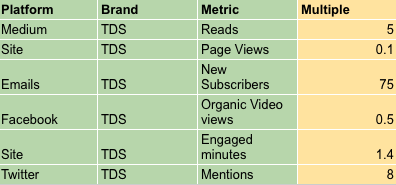
What’s worth more — a Facebook like or a new reader in Apple News? How about a highlight on Medium vs. someone spending 30 seconds reading an article on your website? Are YouTube video views really worth more than those on Facebook?
These are the new kinds of questions facing publishers that have plunged headfirst into the world of platform publishing. Chasing audiences on the platforms they already use is the new publishing strategy du jour, but it’s creating some new tactical wrinkles for publishers uncertain of where to invest and shaky on which metrics matter the most to their bottom lines.
The Daily Signal, the news site run by conservative think tank the Heritage Foundation, also faces this dicey metrics issue. Like many other publishers, the site has made a big strategic push to publish its content on as many platforms and in as many formats as possible. It puts almost all of its content on Medium, for example, has implemented Google AMP on its site, and broadcasts on Facebook Live multiple times per day.The challenges of how to gauge performance on each of these platforms helped birth The Daily Signal’s “engagement index,” an approach to analytics that it uses to weigh and compare audience engagement. To create its engagement index, The Daily Signal listed 70 key individual metrics — such as Medium comments, Facebook video views, and email signups — across all the distribution channels it publishes to and owns. Each metric was assigned a number based on how important it is to The Daily Signal’s goals: Email signups and dollars donated for example, get the highest rankings, while Facebook likes are at the bottom end. Every 15 days, the site tallies up its content’s performance across each platform, assigning scores to each and using those numbers to get an overall picture of how well things are going and what’s driving the most gains.
“With the way our operation works, we’re not in the business of driving traffic to a website. We’re in the business of engaging our audience with content on all their platforms they use,” said Ory Rinat, director of digital strategy at The Heritage Foundation, who previously worked at National Journal and Atlantic Media Strategies. “Looking at Google Analytics for pageviews and unique visitors is a good way to measure traffic to our site, but we knew we needed a way to measure engagement more holistically.”

Rinat said the index gives a more accurate performance picture because it weighs The Daily Signal’s content performance relative to what its goals are, rather than assume all big numbers are automatically good numbers. Thousands of likes on a story posted to Facebook might be a good vanity metric, but a few dozen newsletter signups are more valuable. That’s the kind of difference the index accounts for.
The engagement index has already had significant impact on The Daily Signal’s distribution strategy, particularly when it comes to new platforms such as Medium, where engagement, in absolute terms, is still small. Because the index assigns such a high value to highlights on Medium — particularly if those highlights come from, say, members of Congress — the platform’s had more of strategic importance. “If we were to look at, say, a Medium pageview the same as a pageview on our own site, it would undervalue Medium’s importance to us as an up-and-coming platform,” Rinat said. “With this system, we’re able to say: All things being equal, we care a little more about a pageview on Medium.”
One important caveat here: No two site’s engagement indexes would look exactly alike. The Daily Signal’s metrics rankings are a product of its own strategic goals, which are very different from, say, a publisher that makes its money off of display ads, or one that wants to push people to pay for its print magazine.
“Every organization that takes an approach like this needs to figure out for itself how it values its audience actions,” Rinat said. “This is just how we value our audience’s actions based on our goals for engagement, based on goals for growth and based on the brand that we’re trying to build.”